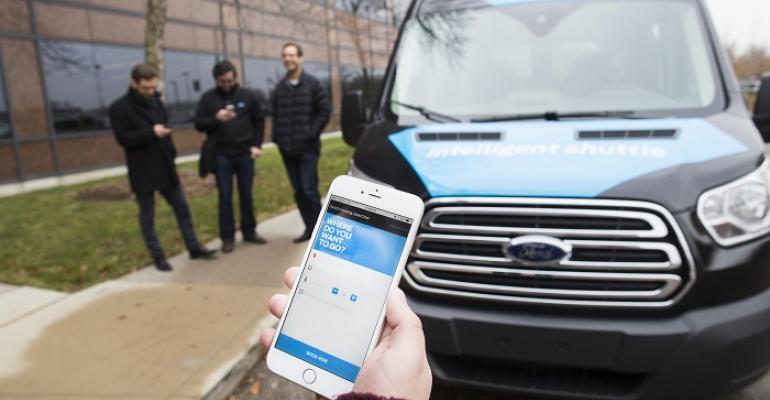DEARBORN, MI – Furthering its Smart Mobility initiative, Ford next week begins a pilot program of its on-demand Dynamic Shuttle service at its global headquarters here.
“This is really exciting because it’s going to enable us to bring van-pooling solutions…for people who want to get around,” Ken Washington, vice president-research and advanced engineering for Ford, tells media today.
Ford will start with four shuttles, modified large Transit vans, picking up and dropping off employees at its Dearborn campus. It hopes to increase the number of shuttles to 21.
Erica Klampfl, global mobility solutions manager-Ford Research and Advanced Engineering, sees the shuttles as fitting between what taxis and buses now offer, with the point-to-point service of the former but the on-demand nature of ride-sharing.
Shuttles will be summoned via a Ford-created app, and users will get feedback when their shuttle is to arrive, at which time they can accept or reject the ride.
An algorithm will determine how best to route shuttles for maximum efficiency and convenience.
Drivers will be able to see scheduled pickups via a tablet mounted on the instrument panel, which also allows them to key in a walk-up rider, a scenario Ford has seen with a current Dearborn Shuttle system in use on its campus. The Dearborn Shuttle service, which Ford sees Dynamic Shuttle replacing, serves 300 riders daily in 129 locations.
Due to research gleaned from developed cities of New York and London, the Dynamic Shuttle service vans will offer plenty of personal space, seating no more than eight, and convenience features, such as USB ports and Wi-Fi.
Ford also did research in developing cities, including Chennai and Mumbai, India, which revealed potential riders care most about having a seat so they don’t have to stand. Yet, consumer feedback there showed Indians aren’t as opposed to less personal space. Klampfl says theoretical Dynamic Shuttles in India could have 18 seats.
Payment May Include Full-Van Discounts
The shuttles in the employee pilot will be free, but Klampfl tells WardsAuto different pricing schemes are being looked at, beyond the pilot phase, based on the capacity of the shuttle. Riders of fuller shuttles, for instance, could get a discount to build goodwill and encourage ride-sharing. All payments would be made via the app.
Washington says, as this is just a pilot, Ford is undecided about how it may implement Dynamic Shuttles. It could run the service itself, sell converted Transits to third parties while licensing the service, or operate the service via a joint venture.
The idea of Smart Mobility “is to have a set of businesses and services that serve the mobility needs of the public, but to do it in a way that makes business sense for Ford,” he says.
Additionally in its efforts toward improving mobility everywhere Ford, in conjunction with West Africa’s Riders for Health, a charity which aims to bring health care to people in remote areas, next year will install its sensor kit originally developed for bicycles on 50 motorcycles used by the charity.
The kit, using OpenXC technology to collect real-time data from vehicles, will help the charity be more efficient and spend more one-on-one time with customers, says Arthur Zysk, Ford’s experiment lead for data-driven healthcare.
“We want to learn how we can make their impact even better,” says Zysk of Riders for Health.
Working with Ford, the charity already has been using OpenXC to track the stops and timing of their routes in Gambia in Ranger trucks and EcoSport SUVs.
The types of data Ford gathered in those vehicles, including windshield-wiper use and GPS data, is beneficial in re-routing motorcycle drivers to roads that haven’t been washed away in Gambia’s 3-month-long rainy season, Zysk says.
Washington tells media Ford sees these mobility endeavors as profitable, otherwise it wouldn’t be experimenting in the space where companies like Uber and Lyft already operate.
Further, he sees Ford marrying its autonomous technology with its mobility endeavors in the not-too-distant future.
He says Ford has transitioned from the research phase on autonomous vehicles to advanced engineering.
“We’re at the point now where we are convinced in the next four years we will have a vehicle that can take the driver fully out of the loop in the right environmental conditions, where the sensors operate well,” he says.





